Take it offline!
This Education in Motion resource is also available as a printable PDF.
Download PDF
After considering the importance of drive wheel position and power seat function requirements, often the next step in prescribing a power wheelchair is deciding how a client will drive the wheelchair and manage any power seat functions.
Consider the client's diagnosis, co-morbidities, and potential for change in function. Is a dramatic change in functional capacity expected? Consider how the client gets in and out of the wheelchair and whether the drive device is compatible. Consider what activities the client wants to do while sitting in the wheelchair and what power seat functions are required to allow this participation. Because we expect power wheelchairs to suit the client for multiple years, it is important to have adaptability and adjustability for degenerative conditions as well as for children who are gaining skills.
Typically, a joystick is mounted at the armrest to provide easy, intuitive driving and control of the power seat functions. But for clients who do not have adequate strength, range of motion, or coordination of their upper limbs, we often need to consider other options called Alternative Drive Controls. These can be as simple as smaller joysticks or as complicated as Bluetooth-paired proximity switches. We'll discuss what each of the devices offers and which types of clients might benefit from their trial.
As with all equipment decisions, there are always considerations and compromises but hopefully, by understanding the key features and benefits of various input devices, you can give advice to clients about which might best suit their lifestyle and usage.
The information below summarizes the features and benefits of wheelchair alternative drive controls. This should be considered a guide, realizing that many other wheelchair features and client goals need to be considered when recommending a complete power wheelchair.
And remember: if it's possible that an attendant might need to assist a client using an alternative drive control, an attendant joystick should be considered for ease of caregiver operation of the chair.
Alternative Drive Controls
Compact Joysticks
Smaller, more compact joysticks mounted for hand control, but require the same range of motion and force to activate as a regular joystick.
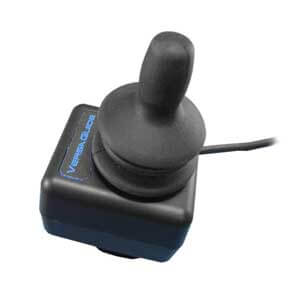 Switch-It VersaGuide
Switch-It VersaGuide
- Joystick is smaller.
- Recommended for pediatric clients where space is at a premium.
- Compact joystick allows younger children with smaller limbs to manage the joystick.
- Recommended for pediatric clients who require easier-to-use joysticks - simpler with fewer buttons.
- Compact joystick has no buttons or screens to distract the client.
- Recommended for clients with cognitive deficits for whom a screen would be distracting.
- Compact joystick can be midline mounted to allow easier access close to the body.
- Recommended for clients who have best control of limbs close to their body.
Micro Joysticks - Mounted at the Hand
Micro-sized joysticks mounted for hand control that require a small range of motion and small force to activate.
- Extremely small force is required to activate joystick.
- Recommended for clients with severe strength deficits.
- Joystick is sensitive - good fine motor control at the finger is required.
- Recommended for clients with good fine motor control at their fingers.
- Extremely small range of displacement is required to activate joystick.
- Recommended for clients with severe range of motion deficits.
Micro Joysticks - Mounted at the Chin
Micro-sized joysticks mounted for chin control that require a small range of motion and small force to activate.
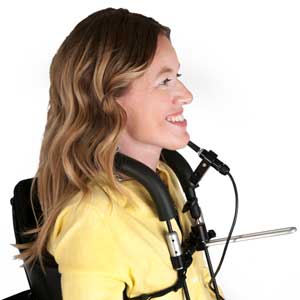 Device can be mounted on a bib-style collar
Device can be mounted on a bib-style collar
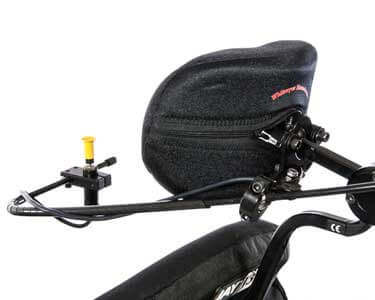 Device can be mounted on a swing-away mount located at the chin
Device can be mounted on a swing-away mount located at the chin
- Joystick is easily mounted for chin/lip control because it is so small and light.
- Recommended for clients with inadequate control of the upper limbs to manage a joystick.
- Extremely small range and force required to activate joystick.
- Recommended for clients who have head control and lip/tongue control to reach and manage sensitive micro joystick.
- Joystick is very small and doesn't obstruct client's face as much as other specialty controls.
- Recommended for clients who would benefit from a very small joystick.
Switched Head Array
Special headrest in which proximity switches are built into the back and side wings of the headrest.
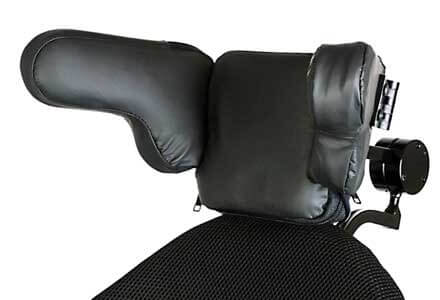 Switch-It Switched Head Array
Switch-It Switched Head Array
- Simple head movements allow directional control of the wheelchair.
- Recommended for clients who have inadequate control of the upper limbs to manage a joystick and client's head offers the best drive control method. Good head control and position are required. Activation of the switch drives the chair in that direction at a designated speed. This is simpler for some clients to understand and manage.
- Device has three head pads with built-in proximity switches.
- Recommended for clients with midline head position and some lateral and anterior/posterior movement of their head.
- Allows directional control, but not speed control.
- Recommended for clients who need a simple form of driving. There is no speed adjustment within the head switches, so driving is not as intuitive or complicated as the Dual Pro.
Dual Pro Head Control
Special proportional headrest with proximity switches and force switches built into the back and side wings of the headrest.
- Device is controlled via head movements.
- Recommended for clients who have inadequate control of the upper limbs to manage a joystick and client's head offers the best drive control method.
- Device has three head pads with built-in proximity and force switches.
- Recommended for clients with midline head position and some lateral and anterior/posterior movement of their head.
- Drive control is activated by proximity switches in each of the three head pads, and speed can be controlled by force applied to the head pads. Activation and amount of pressure applied will make this head array drive similarly to a joystick with acceleration/deceleration and veering capability.
- Recommended for clients with enough head control and cognition to be able to activate three proximity sensors located behind the head and apply differing pressures to alter the speed. Good head control is required to manage both direction and speed variation through special force and proximity switches.
Vigo
A wireless proportional headset that allows drivers to control the wheelchair with subtle and intuitive head movements.
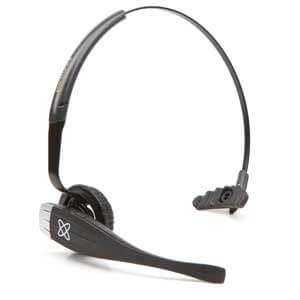 Switch-It Vigo
Switch-It Vigo
- Simple head movements allow directional control of the wheelchair.
- Recommended for clients who have inadequate control of the upper limbs to manage a joystick and client's head offers the best drive control method.
- Minimal head movement is required and the head can be in an asymmetric position, unlike the other head control devices.
- Recommended for clients with just a small amount of head control and cognition to move head in specific directions.
- Vigo headset also functions as a wireless head mouse, allowing drivers to control computers or smartphones.
- Recommended for clients who want to control other devices such as phones or tablets.
- Headset is attached to the person, not the wheelchair, so it can tolerate different seated positions.
- Recommended for clients who frequently use tilt and/or recline, or whose seated position is variable.
Cool Cube™ with Pro Spot™ Proportional Switches
Pro Spot™ proportional switches can be mounted in multiple locations. They are direction-specific and are also proportional, so they have added speed adjustability built in.
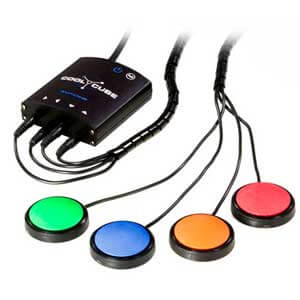 Switch-It Cool Cube with Pro Spot Proportional Switches
Switch-It Cool Cube with Pro Spot Proportional Switches
- Up to five switches can be used and mounted in multiple locations and activated by any part of the body.
- Recommended for clients who don't have enough head control to manage a head array and don't have enough upper limb control to manage a joystick, but can activate and release switches using other parts of their body.
- Pro Spot provides additional sensory input with the varying colors of switches and optional auditory feedback.
- Recommended for use with individuals who may have visual deficits or may benefit from multiple modes of sensory feedback to learn.
- Two switches can be activated at one time to limit the need for more switches/access points. For example, using two switches: red is right, blue is left, and red & blue together is forward.
- Recommended for pediatric clients who have limited access points and for whom you want to limit driving directions and/or simplify driving.
References
- Cook, A.M., Polgar, J.M., Encarnacao P. (2020). Assistive Technologies: Principles and Practice, Fifth Edition. Elseiver, Inc ISBN: 978-0-32352387.
- Lange, M. (2021). Power wheelchair joystick driving methods decision making tree. Access to Independence website joystick-decision-trees.pdf (nccdn.net)
- Lange, M. (2021). Power wheelchair non-joystick driving methods decision making tree. Access to Independence Website non-joystick-driving-methods-decision-making-tree-text-reference.pdf (nccdn.net)
- Lange, M. (2018). Power Mobility: Alternative Access Methods. In M. Lange & J. Minkel (Eds.), Seating and Wheeled Mobility: A Clinical Resource Guide (pp. 179-198). Thorofare, NJ: Slack Incorporated. Updated 5.18.2021.